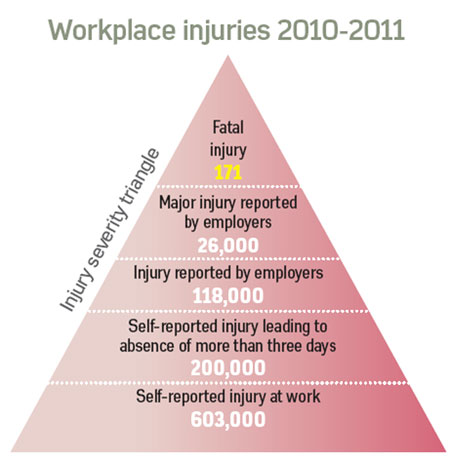A health and safety strategy is not just a legal requirement: it can also boost employee wellbeing and reduce absence levels.
IF YOU READ NOTHING ELSE, READ THIS…
- Employee benefits packages should be designed to support employers’ health and safety policies.
- Health and safety policies should consider both the physical and emotional wellbeing of employees.
- Rapid access to physiotherapy can help to prevent workplace injuries from becoming chronic.
The Health and Safety Executive (HSE) report At a glance guide to health and safety statistics, published in November 2011, shows that 171 people died from work-related injuries in 2010/11. Over the same period, employers reported 118,000 injuries, of which 26,000 were described as major. This resulted in 26.4 million working days being lost.
If that is not enough to prompt employers to ensure their workplace health and safety procedures are legally compliant, then the HSE’s Fee for Intervention scheme should be. Under the scheme, which came into effect in October, employers in breach of health and safety laws will be charged £124 an hour to cover the cost of inspections, investigation and enforcement relating to any shortfall in their health and safety procedures.
Employee benefits packages can be instrumental in helping employers manage workplace health and safety, but what should these include?
Providing an on-site doctor or nurse service is a good place for employers to start. This is an effective way of identifying and treating staff health problems and injuries before they become chronic. For example, an easily accessible medical service will reduce problems associated with common workplace injuries caused by manual handling, slips and trips, and falls from a height. It can also speed up the detection of common health conditions, can be caused or exacerbated by work, such as skin diseases, musculoskeletal disorders, asthma and stress, according to the HSE.
Employers in the manufacturing, agriculture and construction sectors may find extra action is needed to address musculoskeletal problems caused by manual work. Offering employees rapid access to physiotherapy is one of the most effective ways of addressing such ailments.
Less time off work
Sayeed Khan, chief medical adviser at EEF, says an employee who is given access to physiotherapy within 48 hours of an injury is far less likely to see the problem worsen. This not only reduces the time the employee is off work, but also makes it less likely that they will seek compensation from their employer if the accident happened at work.
“It is about treating work-related injuries quickly,” says Khan. “On the whole, people who get injured at work just want to get better.”
Employers should also consider the general health and wellbeing of staff to help prevent workplace stress, which can lead to injury due to loss of concentration, for example.
Employee assistance programmes (EAPs) providing access to confidential counselling services can help staff cope with issues such as workplace stress, poor relationships with line managers, debt and family problems, and can minimise the risk of workplace accidents. Exercise can also help to promote employee wellbeing and eradicate workplace stress. The added benefits of good muscle tone and high levels of physical fitness can also help to reduce accidents, says Khan.
Boost fitness levels
Bikes-for-work schemes, discounted gym membership or on-site gyms are benefits that employers can consider to boost employees’ fitness levels.
Employers can also incentivise staff to play a role in helping to improve the organisation’s health and safety. For example, a corporate reward could be given to the health and safety representative of the year, or bonuses awarded to diligent teams and individuals.
Naomi Saragoussi, principal at Mercer Marsh Benefi ts, says: “Rewarding employees is a sure way to ensure health and safety is improved.”
Whatever an employer’s approach, it must ensure benefi ts are in place to help injured staff quickly and effectively, while working to prevent accidents from happening.
Dr Steven Iley, medical director, occupational health at Axa PPP Healthcare, says: “Occupational health should be preventative, minimising risk and maximising productivity by ensuring the individual is fit to do their job to the best of their ability.”

CASE STUDY: SPRINGFIELDS FUELS

Employees are listened to
Springfields Fuels collaborates with staff to deliver its health and safety strategy.
The nuclear fuel fabrication services provider trains volunteers, including managers, union representatives and frontline workers, to become workplace listeners to whom staff suffering from stress can go for confidential advice.
On-site counselling is provided if needed.
Derek McMillan, site behavioural safety co-ordinator at Springfields Fuels, says: “The listeners are like a sticking plaster: they are the first port of call for employees to have a chat in confidence.”
Other initiatives include a working group comprising union representatives, employees involved in health and safety, management, HR staff and occupational health advisers to examine the impact of shift working on employees’ wellbeing.
Benefits include physiotherapy and annual medical checks for all staff. A nurse is available during working hours and a doctor visits once a week.
Springfields’ strategy has resulted in a significant fall in the number of staff absences due to accidents.
VIEWPOINT

Lukas Rootman, partner, Nabarro
In response to strong economic headwinds, the government and the HSE face pressure from businesses to ease regulatory burdens and adapt the legal requirements that govern health and safety in the workplace. This has manifested in proposals to reduce the number of health and safety inspections required at low-risk workplaces.
But regardless of the direction of health and safety policy, certain minimum legal requirements remain, and compliance has benefi ts for both employers and their staff.
The primary legislation governing health and safety is the Health and Safety at Work Act 1974, which aims to secure the health, safety and welfare of people at work.
Legislation imposes a duty on every employer to ensure, as far as reasonably practicable, the health, safety and welfare at work of all its employees by:
- Providing and maintaining plant and systems of work which are safe and without risks to health.
- Making arrangements to ensure the safe use, handling, storage and transport of articles and substances.
- Providing such information, instruction, training and supervision as is necessary to ensure the health and safety at work of employees.
- Providing a working environment and maintaining any place of work under the employer’s control in a condition that is safe and without risk.
Most workplace policies recognise that looking after employee health and safety contributes to a healthy, productive and happy workforce, and may have secondary benefits, such as controlling insurance premiums.
Protecting employee safety, health and welfare should also enable employers to maintain a close relationship with their staff, and satisfy customers and suppliers that the business is well-run and effectively managed.
Finally, a major driver for protecting employee health and safety is, of course, the necessity to achieve legal compliance.